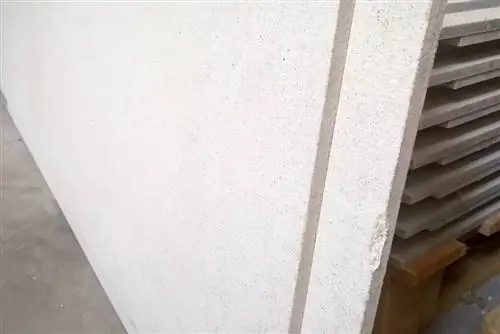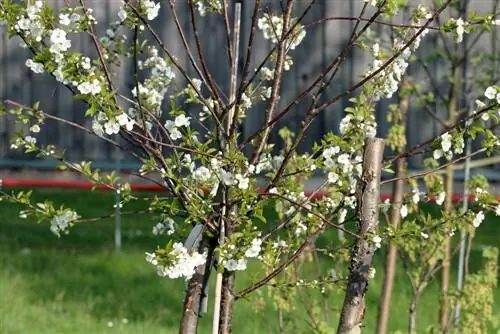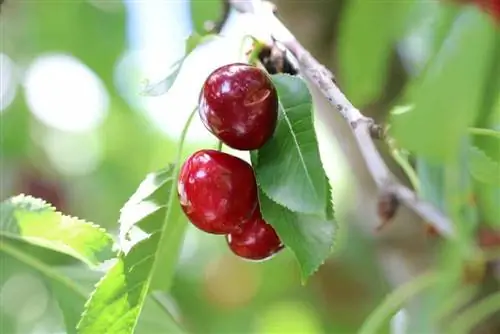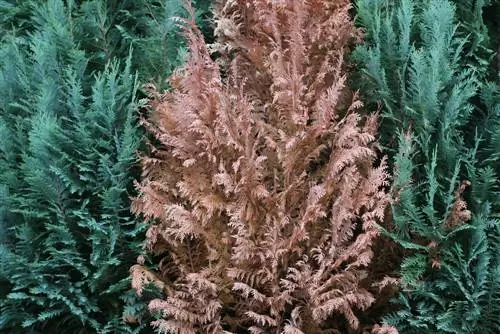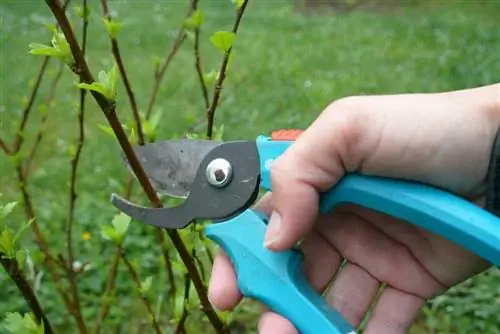- Author admin [email protected].
- Public 2023-12-17 03:39.
- Last modified 2025-06-01 06:48.
Thuja occidentalis Columna is a fascinating plant that is preferred as a hedge plant in many gardens due to its dense, evergreen growth. Characteristic of the tree of life is its column-like shape, which tapers towards the top. Due to this peculiarity, the plant received the trivial nickname “pillar thuja”. Robust and hardy, the exotic plant defies the cold season in our latitudes. When it comes to cutting, the conifer species is frugal and forgives many beginner mistakes.
Location
With its upward columnar shape and short, protruding branches, the conifer is an interesting plant. The hedge conifer is an evergreen plant and in its original form in North America can reach an immense height of up to 20 m. The cultivated form Thuja occidentalis Columna still manages to reach an impressive height of 8 m. This fact should be taken into account when choosing the location. Positive news for passionate hobby gardeners: The Western tree of life grows slowly. The annual growth per year is only about 15 cm.
- full sunny locations are tolerated
- The columnar thuja feels comfortable in partial shade
- Urban climate does not harm plants
- pay attention to underground pipes and cables
Due to their unusual shape and densely arranged, dark green foliage, when planted in groups, the plants create a dense hedge that is hidden from the eyes of curious people all year round. You can create eye-catching, majestic accents with solitary conifers that form the entrance to your garden. Shady places can affect the growth of the tree of life. The height of growth is reduced when there is a lack of light, and the density of the leaves and shoots also suffers. Young arborvitae can get used to dark locations more easily than older plants. Fully shaded areas are unsuitable for hedges.
Caution is advised with small children: because all parts of the cypress-like plant are poisonous. Even brief skin contact is enough to cause severe itching and eczema. If you want to cultivate Thuja occidentalis Columna as a hedge, you should take legal regulations into account, such as the minimum distance to neighboring properties. Depending on the size of the plants, it may be difficult to relocate them at a later date. The close proximity to larger deciduous and coniferous trees does not disturb the North American ornamental plants.
Substrate
Good soil contributes significantly to the development and resilience of the columnar thuja. The plant has shallow roots, with only a few main strands penetrating deeper layers of the earth. In this way, older specimens are able to absorb moisture in extremely dry conditions. The substrate should have the following properties:
- permeable
- profound
- humus-rich
- moist
The pH value of the soil plays a minor role. An acidic to alkaline soil is equally acceptable. Problems can arise with a heavily compacted substrate. The growth of the roots suffers and the important supply of oxygen and water can stagnate. When creating the planting area, it makes sense to prepare the soil sufficiently. Using small pebbles orYou can use expanded clay beads to loosen up the substrate permanently.
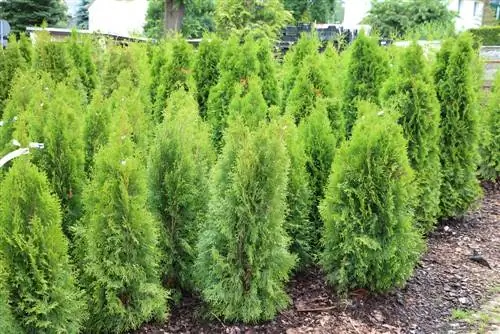
The inorganic material prevents the soil from sticking together, which does not affect regular gardening and plant care. In the first 2 to 3 years of life, the columnar tree of life is suitable for cultivation in a bucket. Use conventional potting soil, which you can enhance with humus, sand and clay.
Pouring
The columnar thuja needs a certain amount of moisture in the soil to develop its dark green foliage. Like all evergreen plants, the root ball of Thuja occidentalis Columna must not dry out even in winter. A mistake that is often made is to leave the plants completely to their own devices during the cold season. In the case of freshly planted and young arborvitae, this can quickly lead to drying out. While older plants can largely provide themselves with water, provided the soil offers the right conditions, you should water younger plants regularly.
- watering all year round
- In winter, water is supplied on frost-free days
- water with a smaller amount in the cold season
- calcareous water does not harm the conifers
- do not water at midday on hot summer days
Water as soon as the top layer of substrate feels dry and crumbly. To be on the safe side, you can use your finger to check when the optimal time to water is. Similar to drought, waterlogging can cause considerable damage to the thuja. If the underground parts of the plant are constantly exposed to large amounts of water, this promotes infestation with ascomycete fungi.
The pathogens settle on the roots and decompose them from the inside. A strong, musty smell is a clear indication of root rot. There is no cure for this disease. Protect the columnar thuja from this by mulching the soil regularly and watering in smaller amounts more often.
Tip:
A “watering edge” has proven useful for a solitary Thuja occidentalis Columna. This makes it easier to water large plants.
Fertilize
The plant with the columnar growth has weak to moderate growth. To promote this, you should supply the tree of life with nutrients from April to August. For example, work compost into the soil in spring and late summer. Horn shavings and brushwood have also proven useful. Bark mulch is optimal for the plant. The material warms the ground in winter, prevents the soil from drying out too quickly and at the same time supplies the plant with important nutrients and minerals.
Alternatively, you can use a universal liquid or long-term fertilizer from the market. Reduce the amount stated on the packaging. An overdose of fertilizer only becomes noticeable after weeks. The leaves and shoots almost always have a yellowish discoloration. In such a case, you should stop fertilizing completely for about 3 months and wait until the plant has recovered sufficiently. Fertilization is no longer carried out from the end of August. At this point, Thuja occidentalis Columna is preparing for winter and is no longer able to adequately utilize the nutrients supplied.
Propagate
The columnar tree of life Columna can be easily propagated by cuttings. Between August and mid-September is a suitable time for this measure.
- select young, non-woody shoots
- carefully tear this off the mother plant
- Cuttings should be between 8 and 12 cm long
- Remove secondary shoots and lower pairs of leaves
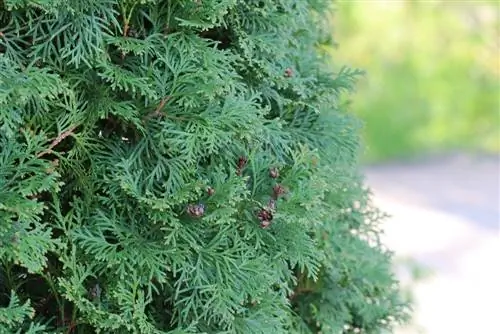
A piece of bark from the main plant should be retained. This “heel”, which should be approximately 1 cm long, facilitates the rooting of the cuttings. 2 pairs of leaves at the top of the shoot are sufficient to ensure the important photosynthesis. The length and number of leaves can cost a lot of energy, which unnecessarily delays root formation.
- Insert thuja cuttings immediately into lean substrate
- if available, moisten the “heel” with a root preparation
- Mixture of potting soil, peat and sand has proven itself
- Shoots should be inserted 2/3 deep into the soil
- keep evenly moist
The location should be bright, but not sunny. Direct sunlight causes the substrate to dry out quickly and puts unnecessary stress on the cuttings. Water moderately so that waterlogging does not occur. To accelerate root growth, the ambient temperature should be between 18° - 22° C. If these requirements are missing outdoors, you can propagate in the greenhouse or on the windowsill. You can temporarily increase the humidity immediately around the cuttings by making a kind of improvised greenhouse. For this purpose, small wooden sticks are attached to the edge of the vessel. A perforated film ensures that the moisture in the substrate cannot evaporate.
The first years of life of the cuttings
Under ideal conditions and proper care, the young plants will have a fine network of roots after about 2 months. As soon as new leaves and shoots appear, the roots have successfully developed. Alternatively, try carefully pulling the cutting out of the container. If a fine network of roots is already present, you will notice this in the resistance. Thuja occidentalis Columna can be transplanted into the garden all year round. However, columnar arborvitae lovers take a different approach to maintaining strong and he althy plants.
- After rooting, transfer the cuttings to separate pots
- fertilize regularly from March
- Transfer plants and containers to a sunny location in warm spring
- repot into a larger container in late summer
Repeat this procedure the following year and only replant the plants in their 3rd or 4th year of life. In this way, North American ornamental plants can develop optimally.
Plants
The “tree of life”, as the columnar thuja is often colloquially referred to, is a robust plant. Specimens with a well-developed root network and strong shoots can be transplanted into the garden all year round. In winter, this measure is carried out on frost-free days. Plants planted in early autumn have good conditions for vigorous sprouting in spring. The following steps have proven effective for solitary planting:
- Planting hole should be twice the size of the plant's root ball
- Mix excavated earth with clay, sand and humus
- a few handfuls of compost in the planting hole
- loose up the surrounding soil
- Insert columnar thuja and fill cavities with substrate
- pour heavily
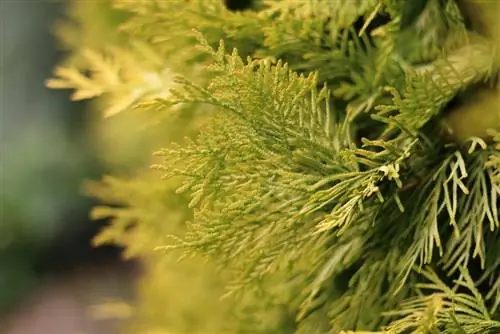
You should proceed a little differently when designing a hedge. Please plan that the columnar arborvitae can reach a width of up to 1.5 m. Secure the planned area with battens and barrier tape. This will give you a first impression of the course of the hedge. You can easily make changes and correct errors at this stage.
- Dig up the bed area generously
- minimum depth should be 30 cm
- Provide soil with drainage
Depending on the size of the plants and the desired density, between 2 - 4 plants are planted per square meter. If the distance is too large, it will take a long time for the hedge to become opaque. In the first year, individual bushes can be moved without much effort.
Cutting
The popular hedge conifer plants tolerate cutting, but there are a few special features to consider. The plants only recover very slowly from a radical cut back into the old wood. Topiary pruning is usually done towards the end of winter, shortly before the plant sprouts. The fresh shoots and buds quickly cover the interfaces.
- only cut young shoots
- Old wood no longer sprouts
- retain small flaky tips
- You can cut dead and cross-growing shoots all year round
- Taper shape upwards
Don't leave the columnar arborvitae completely to their own devices. The weight in the shoots increases as the plants grow taller and makes them susceptible to windthrow. You should cut back the plants a few centimeters a year. If the scaled green tips of the woody shoots are completely removed, they will no longer sprout. Over time, the bare spots will be covered by the side shoots. You can take advantage of this fact and shape the columnar thuja into extraordinary shapes. Start this “education” as early as possible so as not to suffer any visual losses.
Tip:
The sap of Thuja occidentalis Columna is aggressive. For this reason, it makes sense to use gloves for direct care.
Wintering
Cold and frost in our latitudes do not interest North American plants. Thuja occidentalis Columna can easily survive double-digit temperatures of up to -30° C. The greatest danger in winter is not death from freezing, but rather drying out of the roots. A relevant care measure for the columnar thuja is the supply of water. Young and freshly planted plants must not dry out even in the cold season.
- do not fertilize in the winter months
- regularly check the moisture in the substrate
- If necessary, apply bark mulch or brushwood
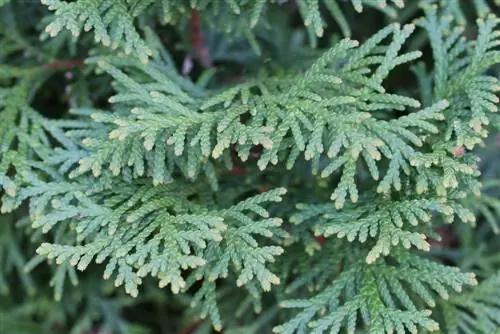
Conifers in pots are an exception and should be adequately prepared before the first frost sets in. This is done by wrapping the vessel with burlap or a special fleece. In this way you prevent the substrate in the pot from freezing completely and the roots from being damaged. In the warm spring you can remove the protection again.
Conclusion
The columnar tree of life Columna is an interesting plant. Many gardeners take advantage of the benefits of the arborvitae and use it as a resilient and easy-care hedge plant. Thanks to its characteristic, column-like shape, the plant also enchants smaller front gardens and entrance areas. The pruning tolerance of Thuja occidentalis Columna must be viewed with a few caveats. Old wood that is cut too deeply will no longer sprout at the tip. This can have a negative effect on the growth habit.


